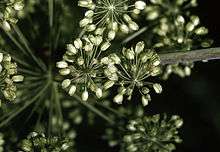Angelica atropurpurea
| Angelica atropurpurea | |
|---|---|
 | |
| Scientific classification | |
| Kingdom: | Plantae |
| (unranked): | Angiosperms |
| (unranked): | Eudicots |
| (unranked): | Asterids |
| Order: | Apiales |
| Family: | Apiaceae |
| Genus: | Angelica |
| Species: | A. atropurpurea |
| Binomial name | |
| Angelica atropurpurea L. | |
| Synonyms[1] | |
| |
Angelica atropurpurea, known commonly as purplestem angelica, great angelica, American angelica, high angelica, and masterwort,[2] is a species of flowering plant that can be found in moist and swampy woodlands, mostly by riverbanks, in eastern North America. It has been found in eastern Canada (Nunavut, Ontario, Quebec, Labrador, Newfoundland, all 3 Maritime Provinces) and the United States (from New England south as far as North Carolina, and west to Minnesota, Iowa, and Tennessee).[3]
The plant grows to 6 feet (180 cm) tall. The erect, branching stem is purple, smooth, hollow, and sturdy. The leaves are divided into segments. The total width of a lower leaf may be up to 2 feet (60 cm). The plant has white to greenish flowers in umbrella-like umbels. One umbel may have as many as 40 branches and be up to 8 inches (20 cm) across. The stalks can be eaten like celery and the flavor is similar. Early American settlers boiled parts of the plant to make into candy and added it to cakes. In Europe, it was believed that the plant could cure alcoholism.[4]
The aromatic root of angelica has widespread use as a purification herb among the Native American cultures. In California, it is often burned during a shaman's prayers in a healing ceremony.[5]
References
- ↑ The Plant List, Angelica atropurpurea L.
- ↑ Purplestem Angelica. The Center for New Crops & Plant Products. Purdue University.
- ↑ Biota of North America Program 2014 state-level distribution map
- ↑ Runkel, S. T. and A. F. Bull. Wildflowers of Iowa Woodlands. 1979. page 139.
- ↑ Lyon, William S. (1998). Encyclopedia of Native American Healing. W.W. Norton & Company, Inc. p. 16. ISBN 0-393-31735-8.
